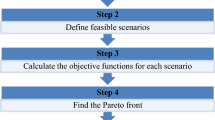Abstract
The development of future wireless access networks often results in very high energy consumption. To reduce this consumption, decision-makers (DM) minimize the number of base stations (\(\hbox {BS}_s\)) installed while using a dynamic BS on/off strategy. However, reducing the number of base stations leads to insufficient network coverage. Indeed, for better coverage, the decision-maker (DM) should install enough base stations. We can therefore see that we have two contradictory objectives. On the other hand, we can easily notice that the information of the network traffic evolves over time. Therefore and in order to make a realistic study, we will consider the traffic information as an imprecise and uncertain value instead of a constant value. For the reasons aforementioned, we introduce in this paper, a fuzzy multi-objective mathematical model in which each traffic is a fuzzy variable, and then, we present a decision-making model based on possibility theory. To solve this problem, we used two meta-heuristic algorithms. The obtained results proved the efficiency of our model compared to previous studies. Indeed, the proposed methodology results not only in a reduction of \(\hbox {CO}_2\) emissions (between 18.15 and 24.18%) but also guarantees good network coverage.









Similar content being viewed by others
References
Dahmani, S., Gabli, M., Mermri, E.B., Serghini, A.: Optimization of green RNP problem for LTE networks using possibility theory. Neural Comput. Appl. 1–14 (2019)
Al-Kanj, Lina, El-Beaino, Wissam, El-Hajj, Ahmad M., Dawy, Zaher: Optimized joint cell planning and BS on/off switching for LTE networks. Wirel. Commun. Mob. Comput. 16(12), 1537–1555 (2016)
Mharsi, N., Hadji, M.: A mathematical programming approach for full coverage hole optimization in Cloud Radio Access Networks. Comput. Netw. 150, 117–126 (2019)
Hemazro, T.D., Jaumard, B., Marcotte, O.: A column generation and branch-and-cut algorithm for the channel assignment problem. Comput. Oper. Res. 35(4), 1204–1226 (2008)
Sangaiah, A.K., Hosseinabadi, A.A.R., Shareh, M.B., Bozorgi Rad, S.Y., Zolfagharian, A., Chilamkurti, N.: IoT resource allocation and optimization based on heuristic algorithm. Sensors 20(2), 539 (2020)
Kashyap, N., Kumari, A.C., Chhikara, R.: Multi-objective Optimization using NSGA II for service composition in IoT. Procedia Comput. Sci. 167, 1928–1933 (2020)
Mohammed, G., Soufiane, D., Bekkaye, M.E., Abdelhafid, S.: Optimization Of multi-objective and green LTE RNP problem. In: 2019 International Conference on Wireless Technologies, Embedded and Intelligent Systems (WITS) (pp. 1–6) . IEEE (2019)
Sangaiah, A.K., Sadeghilalimi, M., Hosseinabadi, A.A.R., Zhang, W.: Energy consumption in point-coverage wireless sensor networks via bat algorithm. IEEE Access 7, 180258–180269 (2019)
Ghazzai, H., Yaacoub, E., Alouini, M.-S., Abu-Dayya, A.: Optimized smart grid energy procurement for LTE networks using evolutionary algorithms. IEEE Trans. Veh. Technol. 63(9), 4508–4519 (2014)
Chen, H., Zhang, Q., Zhao, F.: Energy-efficient joint BS and RS sleep scheduling in relay-assisted cellular networks. Comput. Netw. 100, 45–54 (2016)
Gong, Jie, Thompson, John S., Zhou, Sheng, Niu, Zhisheng: Base station sleeping and resource allocation in renewable energy powered cellular networks. IEEE Trans. Commun. 62(11), 3801–3813 (2014)
Bhuvaneswari, P., Nithyanandan, L.: Improving energy efficiency in backhaul of Lte-a network with base station cooperation. Procedia Comput. Sci. 143, 843–851 (2018)
Chowdhury, A., De, D.: FIS-RGSO: dynamic fuzzy inference system based reverse glowworm swarm optimization of energy and coverage in green mobile wireless sensor networks. Comput. Commun. 163, 12–34 (2020)
Pradhan, P.M., Panda, G.: Connectivity constrained wireless sensor deployment using multiobjective evolutionary algorithms and fuzzy decision making. Ad Hoc Netw. 10(6), 1134–1145 (2012)
Luna, F., Zapata-Cano, P.H., González-Macías, J.C., Valenzuela-Valdés, J.F.: Approaching the cell switch-off problem in 5G ultra-dense networks with dynamic multi-objective optimization. Future Gener. Comput. Syst. 110, 876–891 (2020)
Vallero, G., Deruyck, M., Meo, M., Joseph, W.: Base Station switching and edge caching optimisation in high energy-efficiency wireless access network. Comput. Netw. 108100,(2021)
Nasr-Esfahani, N., Ghahfarokhi, B.S.: Power management in green FFR-based heterogeneous cellular networks. Phys. Commun. 46, 101285 (2021)
Park, J.H., Jin, J.H., Kim, D.K.: A new traffic load based cell zooming algorithm in dense small cell environments. In: 2015 7th International Conference on Ubiquitous and Future Networks (pp. 332–337). IEEE (2015)
Herrería-Alonso, S., Rodríguez-Pérez, M., Fernández-Veiga, M., López-García, C.: An optimal dynamic sleeping control policy for single base stations in green cellular networks. J. Netw. Comput. Appl. 116, 86–94 (2018)
Gabli, M., Jaara, E.M., Mermri, E.B.: A genetic algorithm approach for an equitable treatment of objective functions in multi-objective optimization problems. IAENG Int. J. Comput. Sci. 41(2) (2014)
Gabli, M., Jaara, E.M., Mermri, E.B.: Planning UMTS base station location using genetic algorithm with a dynamic trade-off parameter. In: International Conference on Networked Systems, pp. 120–134. Springer, Berlin (2013)
Katagiri, H., Mermri, E.B., Sakawa, M., Kato, K., Nishizaki, I.: A possibilistic and stochastic programming approach to fuzzy random MST problems. IEICE Trans. Inf. Syst. 88(8), 1912–1919 (2005)
Sakawa, M.: Fuzzy Sets and Interactive Multiobjective Optimization. Springer, Berlin (2013)
Kirkpatrick, S., Gelatt, C.D., Vecchi, M.P.: Optimization by simulated annealing. Science 220(4598), 671–680 (1983)
Auer, G., Blume, O., Giannini, V., Godor, I., Imran, M., Jading, Y., Katranaras, E. et al.: D2.3: Energy efficiency analysis of the reference systems, areas of improvements and target breakdown. EARTH Energy Aware Radio Netw. Technol. (2012)
Koutitas, G.: Low carbon network planning. In: 2010 European Wireless Conference (EW), pp. 411–417. IEEE (2010)
Author information
Authors and Affiliations
Corresponding author
Ethics declarations
Conflict of interest
On behalf of all authors, the corresponding author states that there is no conflict of interest.
Additional information
Publisher's Note
Springer Nature remains neutral with regard to jurisdictional claims in published maps and institutional affiliations.
Rights and permissions
About this article
Cite this article
Dahmani, S., Gabli, M. & Serghini, A. A green fuzzy multi-objective approach to the RNP problem for LTE networks . Prog Artif Intell 11, 29–41 (2022). https://doi.org/10.1007/s13748-021-00259-x
Received:
Accepted:
Published:
Issue Date:
DOI: https://doi.org/10.1007/s13748-021-00259-x




